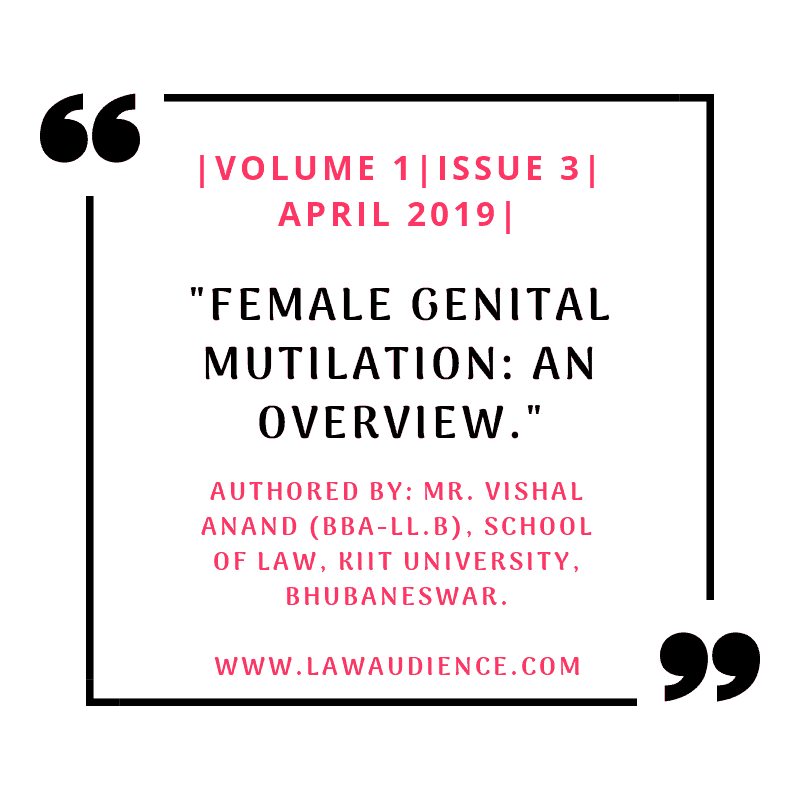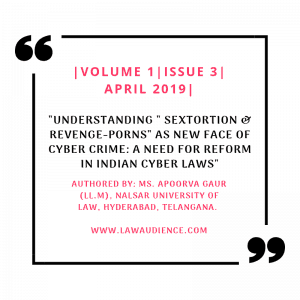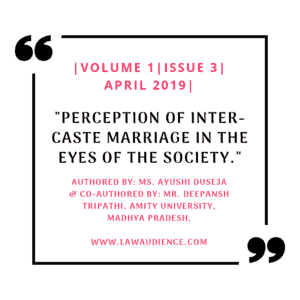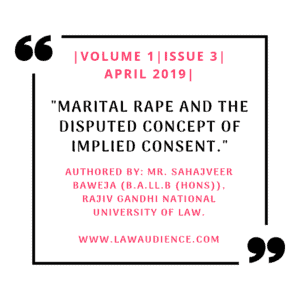AUTHORED BY: MR. VISHAL ANAND (BBA-LL.B), SCHOOL OF LAW, KIIT UNIVERSITY, BHUBANESWAR.
I. ABSTRACT:
“Female Genital Mutilation (FGM) is a system or process which includes partial or absolute evacuation of the female outer genitalia or causing damage to the female genital organs. There is no medical justification for this i.e., why this kind of process is performed on the females. There are various types or procedure in which Female Genital Mutilation is performed, which has been discussed in detail. Though the origin of Female Genital Mutilation is not known due to lack of conclusive evidences but, however, theories and researches have shown that the practice of Female Genital Mutilation has its origination in Egypt. It is believed that Female Genital Mutilation is performed due to traditional belief and culture but it is practiced as a part of religion, especially in ‘Dawoodi Bohra (Muslim) Community of India’. Whether it’s a myth or not, will soon come to know. Female Genital Mutilation violates many rights. First of all, according to Indian laws, it violates the Fundamental Rights guaranteed under the Constitution of India, 1950. It is also considered an offence under the Penal laws of India, i.e., Indian Penal Code, 1860 and The Protection of Children from Sexual Offences Act, 2012.
Various International Instruments have also considered FGM as an infringement of basic human rights and it also violates some of the International Conventions i.e., the Charter of the United Nations and The Universal Declaration of Human Rights (UDHR), 1948; United Nation Convention on the Rights of the Child (UNCRC), 1990; UN General Assembly Resolution, 2012.
Keywords: Dawoodi Bohra Community, Fundamental Right, POCSO, UDHR, UNCRC, UN.”
II. INTRODUCTION:
Women have always been treated as second class citizens and have been dominated by the male population of the society. They have been subjected to cruelty since their childhood, or even in the womb. In some cases, women are pressurized by her in-laws to deliver a boy instead of girl child due to the myth that the boy will take the responsibility of the family and will increase the future generations whereas the girl comes with a burden of expenses, such as marriage, dowry and most important, could not increase the future generation of that family. Female genital mutilation, sometimes also known as female sexual mutilation, comprises “all procedures that involve partial or total removal of the external female genitalia, or injury to the female organs for non-medical reasons” (WHO, 1997). It has dangerous consequences for sexual and reproductive health.
III. TYPES OF FEMALE GENITAL MUTILATION:
“Type I: The Prepuce (Clitoral Hood) is removed, sometimes along with part or the entire Clitoris.
Type II: Both the Prepuce and the Clitoris and part or all of the Labia Minora (Inner Vaginal Lips) are removed.
Type III: It is known as Infibulation involves the complete removal of the Clitoris and Labia Minora, together with the inner surface of the Labia Majora.
Type IV: It is a new category that encompasses other surgical procedures, including manipulation of the Genitalia. This includes pricking, piercing, or incision of the Clitoris and/or Labia, stretching of the Clitoris and/or Labia, cauterization by burning of the Clitoris and surrounding tissue, introcision, cuts into the vagina and introduction of substances into the vagina with the aim of tightening or narrowing the vagina[1].”
IV. ORIGINS AND DEVELOPMENTS:
The exact historical and geographical origin of female genital mutilation is obscure but there have been various researches to show that the practice precedes Islam and Christianity[2]. The hypothesis is that the practice originated in the Middle East and the Arabian Peninsula[3]. It is accepted that FGM is an old-age practice, possibly dating as far back as Ancient Egypt[4], which may have originated in what is now Sudan and Egypt. According to Mackie (1996), Female Genital Mutilation has its origination from the west coast of the Red Sea. Female Genital Mutilation is not limited to any one single community, religion, sect or ethnicity.
V. INTERNATIONAL VIOLATIONS:
a) VIOLATES THE UNIVERSAL DECLARATION OF HUMAN RIGHTS, 1948:
The practice of female genital mutilation violates some of the articles laid down in the convention. It violates Human Dignity[5], Right to Life[6] and is treated as an inhuman, cruel and torturous act[7]which results in immediate physical complications like haemorrhage and severe pain, which can also lead to shock and in some cases, death[8]. Acute urinary retention and infections are common consequences of the practice.
b) VIOLATES THE CONVENTION ON RIGHTS OF CHILD, 1990:
The practice of female genital mutilation or Khatna is mostly performed on the children below the age of 18 years. Since the barbaric act of Khatna involves painful procedures and its consequences are not good for the health which leads to infringement of the rights of the child such as discriminating the child on the basis of community/religion[9], violating its inherent right to life and development[10]. The State has the liability to take care of and protect the child of his/her well-being[11].
c) VIOLATES THE UN GENERAL ASSEMBLY RESOLUTION, 2012:
The United Nations in its 67th session of General Assembly took a resolution in the month of December, 2012, bearing resolution number- A/RES/67/146[12] of intensifying global efforts for the elimination of female genital mutilations. The United Nations in this resolution recognized that female genital mutilations are an irreparable, irreversible abuse that impacts negatively on the human rights of women and girls, affecting about one hundred to one hundred and forty million women and girls worldwide, and that each year an estimated further three million girls are at risk of being subjected to the practice throughout the world. It also reaffirmed that female genital mutilations are a harmful practice that constitutes a serious threat to the health of women and girls, including their psychological, sexual and reproductive health, which can increase their vulnerability to HIV and may have adverse obstetric and prenatal outcomes as well as fatal consequences for the mother and the newborn.
VI. FEMALE GENITAL MUTILATION IN INDIA:
The practice of Female Genital Mutilation or ‘Khatna’ is rampant in India and mostly followed by the ‘Dawoodi Bohra (Muslim) Community of India. They are subsect of the Islam. The members from the community believe it to be a part of their religion and claim it to be a fundamental right under Article 26 of the Constitution of India, 1950. Public Interest Litigation has been filed in the Hon’ble Supreme Court of India by Advocate Sunita Tiwari in the year 2017 to ban the practice of Female Genital Mutilation in India. The Hon’ble Court has accepted the petition and has placed the matter before a larger bench[13].
a) VIOLATES ARTICLE 14 & 15(1) OF THE CONSTITUTION OF INDIA, 1950:
The practice violates Article 14 & 15(1) of the Constitution of India, 1950. Article 14 talks about the Right to Equality. Since the practice of female genital mutilation only occurs in the Dawoodi Bohra Community of India which is a subsect of Islam. Thus, it creates discrimination amongst the citizen on the basis of religion and also violates Article 15 (1) of the Constitution of India, 1950. The practice of female genital mutilation is an inhuman act and the women belonging to the Dohra community, who undergoes this practice, is treated unequally as she has been discriminated and treated worse than the other women living in the country[14]. Also, there is clear invidious discrimination amongst the women citizen of the country on the basis of religion due to this practice.[15]
b) VIOLATES ARTICLE 21 OF THE CONSTITUTION OF INDIA, 1950:
The practice violates Article 21 of the Constitution of India, 1950. Article 21 is regarded as the heart of Fundamental Rights[16]. It overrides all other fundamental rights as it has a very broad scope. It says that, ‘No person shall be deprived of his right or personal liberty except according to procedure established by law.’ The scope of Article 21 of the Constitution of India is to be read in its widest sense which resulted in a new dimension and held that the right to live includes within its ambit the right to live with human dignity[17]. Reputation is considered as an important part of one’s life. It is one of the finer graces of human civilization that makes life worth living[18]. The practice of female genital mutilation infringes the right to live with human dignity and the right to reputation not only of the women or child on whom it is practiced but also to the overall members of the Dawoodi Bohra Community.
c) VIOLATES ARTICLE 39 OF THE CONSTITUTION OF INDIA, 1950:
The Practice also violates Article 39 of the Constitution of India, 1950. Article 39 of the Constitution of India contains certain principles which have to be followed by the State. It is known as the Directive Principles of State Policies. Though it is not enforceable in the court of law, but if it has to be run subsidiary to the Fundamental Rights and have to confirm them[19].
d) FEMALE GENITAL MUTILATION AND THE RELIGIOUS MYTHS:
The practice is not a religious practice under Article 25 of the Constitution of India, 1950. In order to prove the practice of female genital mutilation, we need to know about what religious practices means and includes. In the layman’s view, religious practices include all those practices which are given in their respective Holy books of every religion. But the pro-activeness of the judiciary had led to the development of Essential Religious Practices test. This test was coined by the Hon’ble Supreme Court way back in the year 1954. The Court mentioned for the first time that for constituting any practice as an essential part of a religion, it will be ascertained with reference to the tenets and doctrines of that religion itself[20]. For constituting any act as a religious practice under any religion or community, it is important to first recognize the identity and existence of that religion or community. Since the Dawoodi Bohra community does not have any existence or identity as it is a subsect of Islam, therefore, the court or legislature cannot interfere into the matters of that particular community[21]. There is nowhere mentioning the practice of female genital mutilation in the holy book of Islam, i.e., ‘Quran’. So it cannot be treated as a religious practice under Article 25 of the Constitution of India.
Sometimes there are practices, even secular ones, usually considered as part of the religion, that might actually be superstitions and not essential to the religion, and hence excluded from the protection of the Constitution[22]. The practice was adopted and followed from the Arabic Countries and since nowhere it is mentioned in ‘Quran’, therefore, the faith or belief based on the practice of ‘Khatna’ might be a superstition which the community is unaware of. The essential practices are those that are accepted by the followers as a method of achieving their spiritual upliftment[23]. It can be said that the practice of female genital mutilation or Khatna is not performed in every Muslim family or the family who follows the tenets of Islam. This practice originated in the Middle East, in Egypt, and predated both Islam and Christianity. Also, this practice does not provide any spiritual upliftment.
Personal law has constitutional protection. This protection is extended to ‘personal law’ through Article 25 of the Constitution. It needs to be kept in mind, that the stature of ‘personal law’ is that of a fundamental right. Stated differently, ‘personal law’ of every religious denomination, is protected from invasion and breach, except as provided by and under Article 25. In the instant scenario, the practice of female genital mutilation violates public order, morality and health under Article 25 and thus cannot be regarded as a religious practice[24].
e) OFFENCE UNDER INDIAN PENAL CODE, 1860:
The procedures involved in the practice of female genital mutilation causes hurt and lead to severe infections or diseases. Hurt is defined under § 319 of the Indian Penal Code, 1860 as, ‘Whoever causes bodily pain, disease or infirmity to any person is said to cause hurt.’ The act of performing ‘Khatna’ attracts Sec. 321 of the Indian Penal Code, 1860 which talks about voluntarily causing hurt. The person involved in this practice should be booked under Sec. 323 of the Indian Penal Code, 1860 which describes the quantum of punishment for voluntarily causing hurt. The procedure in the female genital mutilation also sometimes involves Force or Criminal force as defined under Sec. 349 & 350 of the Indian Penal Code, 1860. The person who conducts ‘Khatna’ on any girl or woman should be punished under Sec. 352 of the Indian Penal Code, 1860 which describes the quantum of punishment for assault or criminal force.
f) OFFENCE UNDER PROTECTION OF CHILDREN FROM SEXUAL OFFENCES ACT (POCSO), 2012:
The practice of female genital mutilation or Khatna is done by a medical tool/instrument and can be said as a surgical knife for removal of all or part of female the genitalia. This act attracts Sec. 3(b) of the POCSO Act which says that, ‘A person is said to commit “penetrative sexual assault” if he inserts, to any extent, any object or a part of the body, not being the penis, into the vagina, the urethra or anus of the child or makes the child to do so with him or any other person. ‘The doctor or the person involved in performing this act uses that knife, for the removal of genitalia, which can be defined as any object inserted in the vagina and should be punished under Sec. 4 of the POCSO Act which describes the quantum of punishment.
The practice of female genital mutilation is done by medical professionals/doctors under their supervision. This act attracts Sec. 5 (e) of the POCSO Act which says that, ‘Whoever being on the management or staff of a hospital, whether Government or private, commits penetrative sexual assault on a child in that hospital.’ The doctor of the person involved in performing this act should be punished under Sec 6 of the POCSO Act which describes the quantum of punishment.
VII. CONCLUSION:
There is no law regarding the practice of female genital mutilation in India and therefore the practice is still going on rapidly. The members of the Dawoodi Bohra community are also the followers of Islam and since the practice has preceded Islam, it cannot be said that the practice is their religious right or custom because it is not practiced by each and every member of the religion and also the ‘Quran’ is silent on this. The practice of female genital mutilation is regarded as an offence in some countries and many of the countries have initiated the process of banning the practice. The practice is banned in the United States of America. Minnesota and North Dakota passed laws by introducing bills in New York and New Jersey’s legislatures in 1995 banning female genital mutilation[25]. More than 100 million women worldwide are affected due to the practice of female genital mutilation as the procedure has many complications including dyspareunia, sepsis and death[26]. In the United Kingdom, female genital mutilation is already an offence made in the year 1985 with a penalty of up to 14 years in prison.
The people who practiced female genital mutilation have been convicted[27] in some of the foreign courts. The court approaches in those cases are based on justice, equality, morality and good conscience.[28] Even in some cases, the court has also passed protection orders for the girl child who was in danger of undergoing the practice of female genital mutilation[29].
By practicing ‘Khatna’ we are giving burden on the girls to follow the principles of that community but we don’t know whether that girl will adopt that community in future or not. It is possible that she might convert into another religion or even marry someone outside her community. Also, such practice is performed without their consent. Therefore, it is high time for the Government of India to enact new legislation, laying down certain rules and regulations regarding the ban of female genital mutilation or ‘Khatna’ and making it as an offence punishable by law.
[1] Efua Dorkenoo, Combating Female Genital Mutilation: An Agenda for Next Decade, Women’s Studies Quarterly, Vol. 27, (1999), pp. 87-97, http://www.jstor.org?stable/40003401.
[2] J.A. Black, et al, G.D. Debelle, et al, Colette Gallard & Rupert Walder, Female Genital Mutilation in Britain, British Media Journal, Vol. 310, (Jun. 17, 1995), pp. 1590-1594, http://www.jstor.org/stable/29727627.
[3] Armelle Andro & Marie Lesclingand, Female Genital Mutilation: Overview and Current Knowledge, Population (English Edition, 2002), Vol. 71, (2016 Apr-Jun), pp. 216-273, http://www.jstor.org/stable/44135271.
[4] Female Genital Mutilation is believed to have appeared later than male circumcision, which is attested in Egypt as early as the third millennium BCE (Erlich, 1986).
[5] Article 1 of the UDHR Convention.
[6] Article 3 of the UDHR Convention.
[7] Article 5 of the UDHR Convention.
[8] supra note 1.
[9] Article 2(2) of Child Rights Convention.
[10] Article 6 of Child Rights Convention.
[11] Article 3(2) of Child Rights Convention.
[12] https://undocs.org/A/RES/67/146.
[13] Sunita Tiwari v. Union of India, 2018 SCC OnLine S.C. 2667 (India).
[14] Glanrock Estate (P) Ltd. v. State of Tamil Nadu, (2010) 10 S.C.C. 96 (India).
[15] Bondu Ramaswamy v. Bangalore Development Authority, (2010) 7 S.C.C. 129 (India).
[16] Bandhua Mukti Morcha v. Union of India, (1997) 10 S.C.C. 549 (India).
[17] Maneka Gandhi v. Union of India & Anr, 1978 A.I.R. 597 (India).
[18] D.F. Marion v. Minnie Davis, 55 American LR 171; Smt. Kiran Bedi v. Committee of Inquiry, 1989 A.I.R. 714 (India).
[19] State of Madras v. Champakam Dorairajan and Ors, A.I.R. 1951 S.C. 226 (India).
[20] The Commissioner, Hindu Religious Endowments, Madras v. Shri Lakshmindar Thirtha Swamiyar of Shri Shirur Mutt, A.I.R. 1954 S.C. 282 (India).
[21] Sardar Syedna Tahir Saifuddin Saheb v. State of Bombay, A.I.R. 1962 S.C. 853 (India).
[22] The Durgah Committee Ajmer v. Syed Hussain Ali and Ors, A.I.R. 1961 S.C. 1402 (India).
[23] Commissioner of Police & Ors v. Acharya Jagadishwarananda Avadhuta & Ors, (2004) 12 S.C.C. 770 (India).
[24] Shayara Bano and Ors v. Union of India (UOI) and Ors, A.I.R. 2017 S.C. 4609 (India).
[25] Cad, U.S.: fighting female genital mutilation, http://www.jstor.org/stable/20835386.
[26] Katrina Erskine, Collecting data on female genital mutilation, http://www.jstor.org/stable/10.2307/26514820.
[27] S M G & R A M v. Republic, 2015 S.C.C. Ken 2839 (India).
[28] Katet Nchoe & Nalangue Sekut v. Republic, 2011 S.C.C. Ken 693 (India).
[29] A v. A another, [2018] 4 WLR 105.



